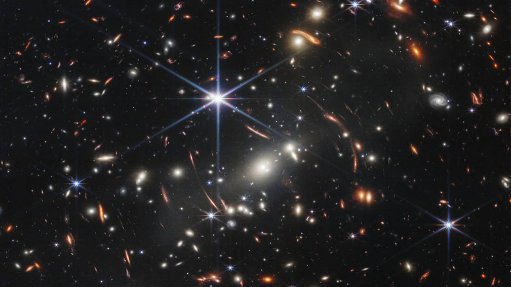
The Webb First Deep Field image; the curved red features are incredibly distant and early galaxies, from some 13.2-billion years ago, the light from which has been gravitationally distorted
Photo by: Nasa
The US National Aeronautics and Space Administration (Nasa) on Monday released the first image produced by its latest instrument, the James Webb Space Telescope. The image, designated Webb’s First Deep Field, captured the SMACS 0723 galaxy cluster. The picture contains thousands of galaxies.
The Webb telescope is now the world’s top space telescope, and is a Nasa-led international programme, the other partners being the Canadian Space Agency and the European Space Agency (ESA). It was actually launched by ESA, on an Ariane 5 rocket, from French Guiana, and operates mainly in the infrared range of the electromagnetic spectrum. It thus complements other, already operating, space telescopes which operate in the visible, ultraviolet and X-ray ranges, such as the Hubble and Chandra instruments. The Webb is also the largest and most powerful space telescope ever launched.
“Webb’s First Deep Field is not only the first full-colour image from the James Webb Space Telescope, it’s the deepest and sharpest infrared image of the distant universe, so far,” highlighted Nasa administrator Bill Nelson. “This image covers a patch of sky approximately the size of a grain of sand held at arm’s length. It’s just a tiny sliver of the vast Universe.”
The SMACS 0723 galaxy cluster lies 4.6-billion light years from Earth. That means that the image shows it as it was 4.6-billion years ago, not as it is today. The mass of the total galaxy cluster serves as a ‘gravitational lens’ (gravity bends light), which magnifies galaxies behind it, which lie much further away from Earth. As a result, the Near-Infrared Camera on the Webb has been able to capture the faintest objects ever observed in the infrared range, as well as bringing very distant galaxies into sharp focus, revealing structures such as diffuse features and star clusters. The image includes galaxies that are 13.2-billion light years away, or, in other words, galaxies that existed only 600-million years after the Big Bang, which created our Universe.
This first image is a composite, compiled from images taken at various infrared wavelengths. These images were collected over a period of 12.5 hours. It took the Hubble Space Telescope weeks to create such deep field images, and its deep field images never achieved the depth (distance) that the Webb has already achieved.
The telescope, named after James Webb, Nasa administrator from 1961 to 1968, was launched on Christmas Day last year. The following months were taken up by it travelling to its operating location (it is orbiting the Sun, not the Earth, at what is known as Lagrange point 2) some 1.5-million kilometres from Earth, and by the deployment and commissioning of its golden reflective mirror and its instruments.